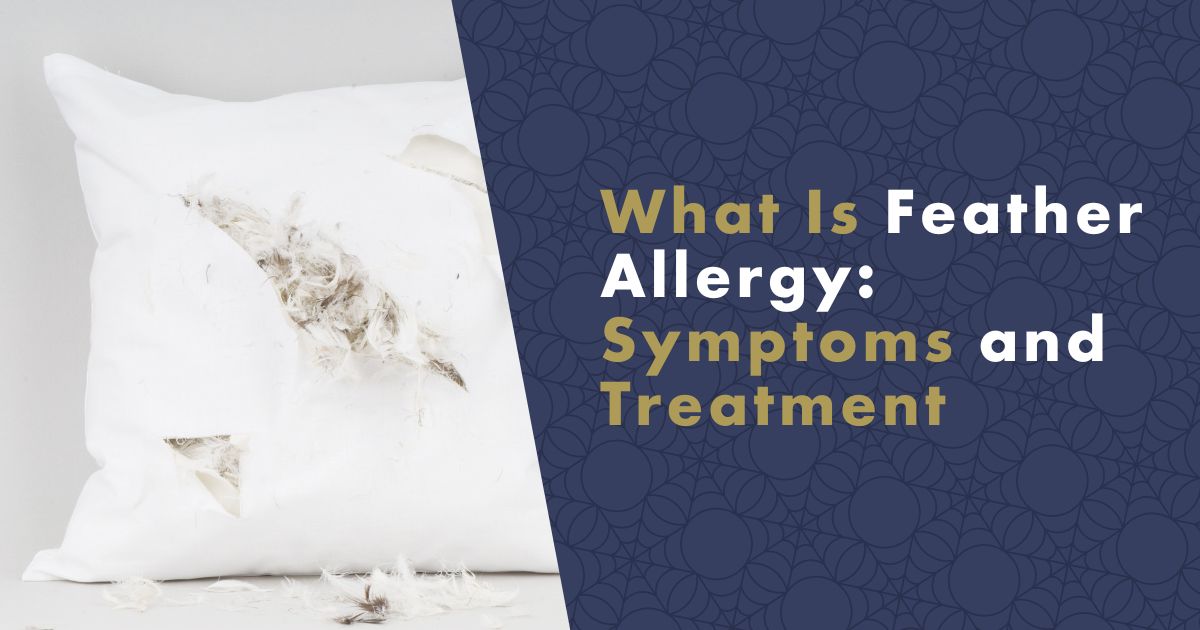Feather allergy is a condition that affects many people, especially those who are sensitive to dust and other allergens. Feathers contain proteins that can trigger an allergic reaction, and symptoms of feather allergy can range from mild to severe. If you have a feather allergy, you may experience symptoms such as sneezing, runny nose, itchy eyes, and congestion when you come into contact with feathers.
Feather allergy is more common in people who have other allergies, such as dust mite allergy or pollen allergy. It is also more common in people who have asthma, because feather allergens can trigger an asthma attack. If you have a feather allergy, it is important to avoid exposure to feathers as much as possible to reduce your symptoms.

What Is Feather Allergy?
Feather allergy is caused by an overreaction of the immune system to proteins found in feathers. When a person with a feather allergy comes into contact with feathers, their immune system mistakenly identifies the proteins in the feathers as harmful and releases antibodies to fight them.
What Are the Most Common Symptoms of Feather Allergy?
The symptoms of feather allergy are similar to those of other allergies, and can include:
- sneezing,
- runny nose,
- itchy eyes,
- and congestion.
Some people may also experience:
- skin irritation or hives,
- and in severe cases, feather allergy can cause difficulty breathing and lead to asthma.

The severity of the symptoms can vary depending on the person's sensitivity to the feather allergens and the amount of exposure to the feathers. In general, the symptoms of feather allergy may be worse at night, when feathers are more likely to come into contact with the skin, and they may be triggered by exposure to feathers, such as in bedding or clothing.
What Is the Difference between Feather and Dust Mite Allergy?
Feather allergy and dust mite allergy are two different conditions, although they have some similarities. Both are caused by an overreaction of the immune system to allergens, and both can cause symptoms such as sneezing, runny nose, and itchy eyes. However, there are some key differences between the two conditions:
- The allergens: The main difference between feather allergy and dust mite allergy is the type of allergen that triggers the allergic reaction. In feather allergy, the allergen is a protein found in feathers. In dust mite allergy, the allergen is a protein found in the feces and body fragments of dust mites.
- The symptoms: Although the symptoms of feather allergy and dust mite allergy may be similar, they can also differ in some ways. For example, feather allergy may cause skin irritation or hives, while dust mite allergy may cause asthma or other respiratory symptoms. The severity of the symptoms may also vary between the two conditions.
- The treatment: The treatment for feather allergy and dust mite allergy may also differ. In most cases, allergy medications, such as antihistamines or nasal sprays, can help reduce the symptoms of both conditions. However, some people with severe feather allergy or dust mite allergy may require stronger medications, such as inhaled corticosteroids or leukotriene modifiers.
- The prevention: To prevent feather allergy and dust mite allergy, it is important to avoid exposure to the allergens that trigger the allergic reaction. For feather allergy, this may involve avoiding products that contain feathers, using allergy-proof covers on your bedding or buying anti dust mite bedding made with nanofiber layer. You should also contact with birds and their feathers. For dust mite allergy, this may involve keeping your home clean, using a HEPA filter, and using anti-dust mite bedding made with nanofiber layer.
Overall, feather allergy and dust mite allergy are two different conditions, but they share some common symptoms and treatment options. If you have either condition, it is important to talk to your doctor for proper diagnosis and treatment.
How to Get Rid of Feather Allergy?

One way to avoid exposure to feathers is to avoid products that contain feathers, such as down comforters, pillows, and clothing. You can also use allergy-proof covers made with nanofiber membrane on your bedding to prevent feathers from coming into contact with your skin. If you have a feather allergy, it is important to read labels carefully and avoid products that contain feathers.
Another way to reduce your exposure to feathers is to keep your home clean. Regularly vacuum and dust your home to remove feathers and other allergens from surfaces. Use a damp cloth or mop to avoid spreading feathers into the air. You can also use a high-efficiency particulate air (HEPA) filter to clean the air in your home.
If you have a feather allergy, it is also important to avoid exposure to birds. Avoid visiting homes or other environments where birds are present, and avoid touching birds or their feathers. If you have a bird at home, keep it out of your bedroom and other areas where you spend a lot of time.
It is also important to talk to your doctor about the best treatment options. Your doctor may recommend allergy medications, such as antihistamines or nasal sprays, to reduce your symptoms. In severe cases, your doctor may prescribe a stronger medication, such as an inhaled corticosteroid or leukotriene modifier. Your doctor may also recommend immunotherapy, also known as allergy shots, to help your body become less sensitive to feather allergens.
Feather allergy is a common condition that can cause uncomfortable symptoms. By avoiding exposure to feathers and keeping your home clean, you can reduce your symptoms and live a more comfortable life.
Frequently Asked Questions
What is feather allergy?
Feather allergy is a condition that affects many people, especially those who are sensitive to dust and other allergens. Feathers contain proteins that can trigger an allergic reaction, and symptoms of feather allergy can range from mild to severe.
What are the symptoms of feather allergy?
The symptoms of feather allergy are similar to those of other allergies, and can include sneezing, runny nose, itchy eyes, and congestion. Some people may also experience skin irritation or hives, and in severe cases, feather allergy can cause difficulty breathing and lead to asthma.
How can I prevent a feather allergy?
To prevent a feather allergy, you can reduce your exposure to feathers by avoiding products that contain feathers, such as feather comforters, pillows, and clothing. You can also use allergy-proof covers made with nanofiber layer on your bedding to prevent feathers from coming into contact with your skin. If you have a feather allergy, it is important to read labels carefully and avoid products that contain feathers..
How can I treat a feather allergy? ?
To treat a feather allergy, your doctor may recommend allergy medications, such as antihistamines, decongestants, or nasal sprays. In severe cases, your doctor may prescribe a stronger medication, such as an inhaled corticosteroid or leukotriene modifier. Your doctor may also recommend immunotherapy, also known as allergy shots, to help your body become less sensitive to feather allergens.
How do I know if I have a feather allergy?
If you have allergy symptoms, such as sneezing, runny nose, and itchy eyes, and you notice these symptoms when you are in a environment with feathers, you may have a feather allergy. To confirm the diagnosis, your doctor may perform a skin prick test or a blood test to measure your immune system's reaction to feather allergens.
Learn More About Allergies:
- How to Recognize Allergies
- Dust Mite Allergies
- Dust Allergies
- Allergy to Cats
- Allergy to Dogs
- Spring Pollen Allergies
- Identifying and Managing Allergies in Infants and Children
- Combined or Cross-Reactive Allergies
- How to Prepare for Allergy Season
Sources
- KILPIÖ, K., et al. Allergy to feathers. Allergy, 1998, 53.2: 159-164.
- TAUER‐REICH, I., et al. Allergens causing bird fancier's asthma. Allergy, 1994, 49.6: 448-453.
- COLLOFF, M. J. Taxonomy and identification of dust mites. Allergy, 1998, 53: 7-12.
- SÁNCHEZ-CARABALLO, Jorge; DIEZ-ZULUAGA, Susana; CARDONA-VILLA RICARDO, Ricardo. Sensibilización a aeroalérgenos en pacientes alérgicos de Medellín, Colombia. Revista Alergia de Mexico, 2012, 59.3.
- SULTÉSZ, Monika, et al. Prevalence of allergic rhinitis, related comorbidities and risk factors in schoolchildren. Allergy, Asthma & Clinical Immunology, 2020, 16: 1-11.

